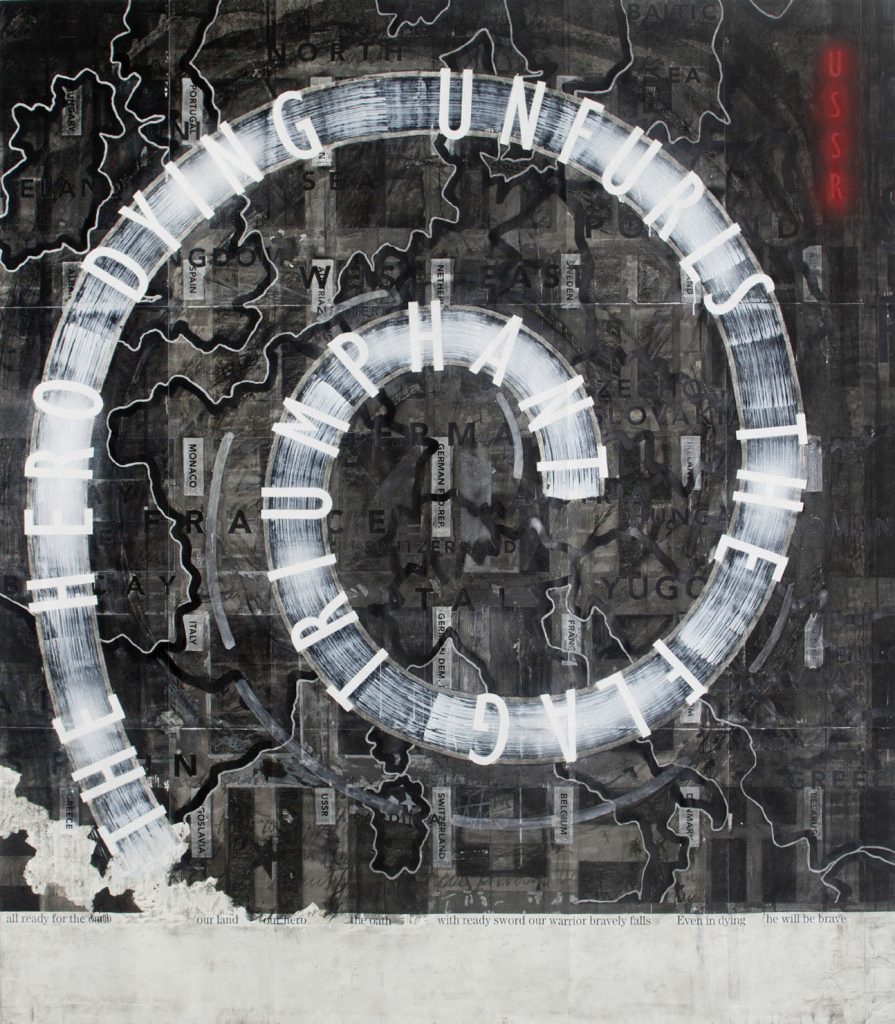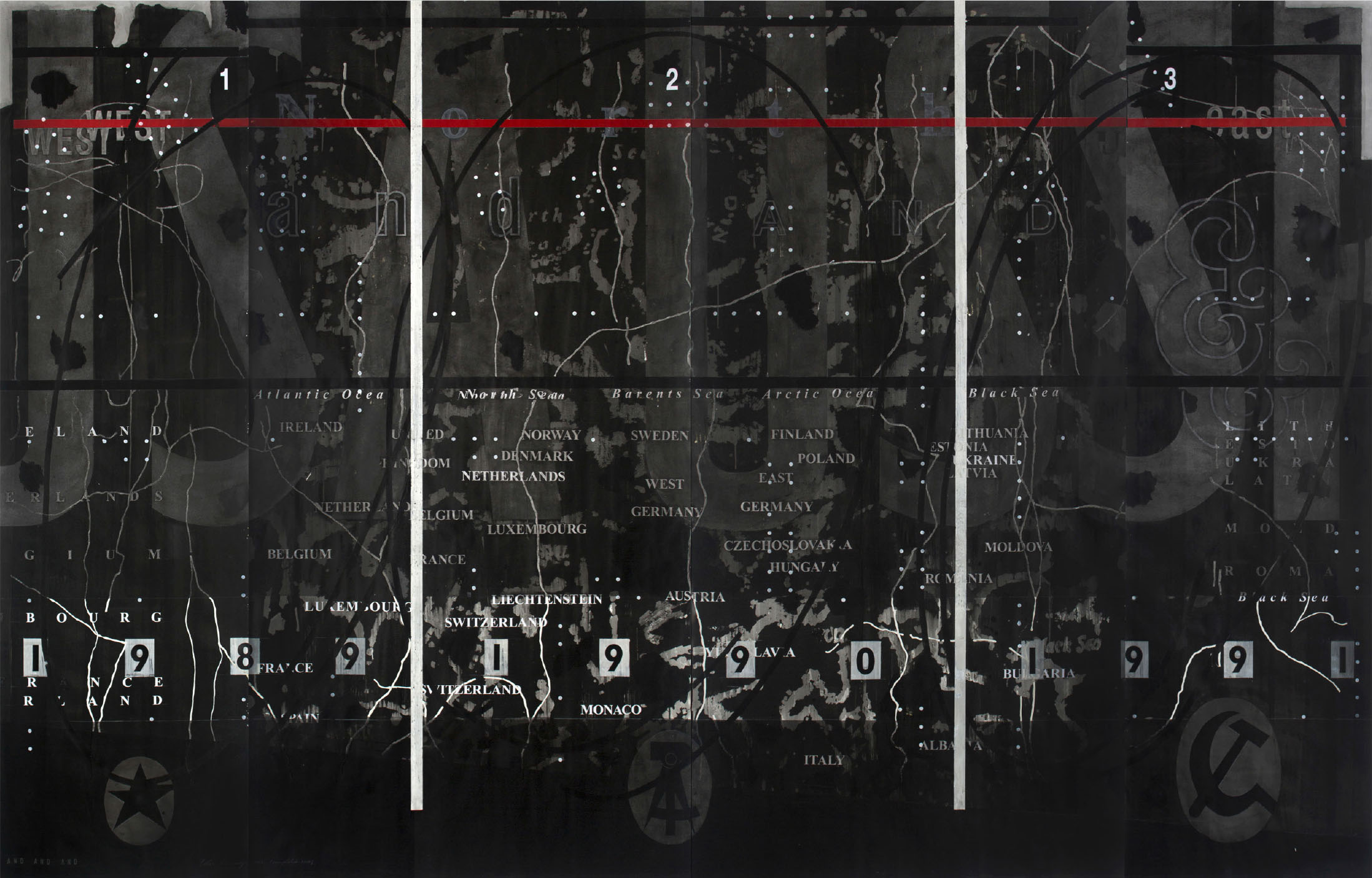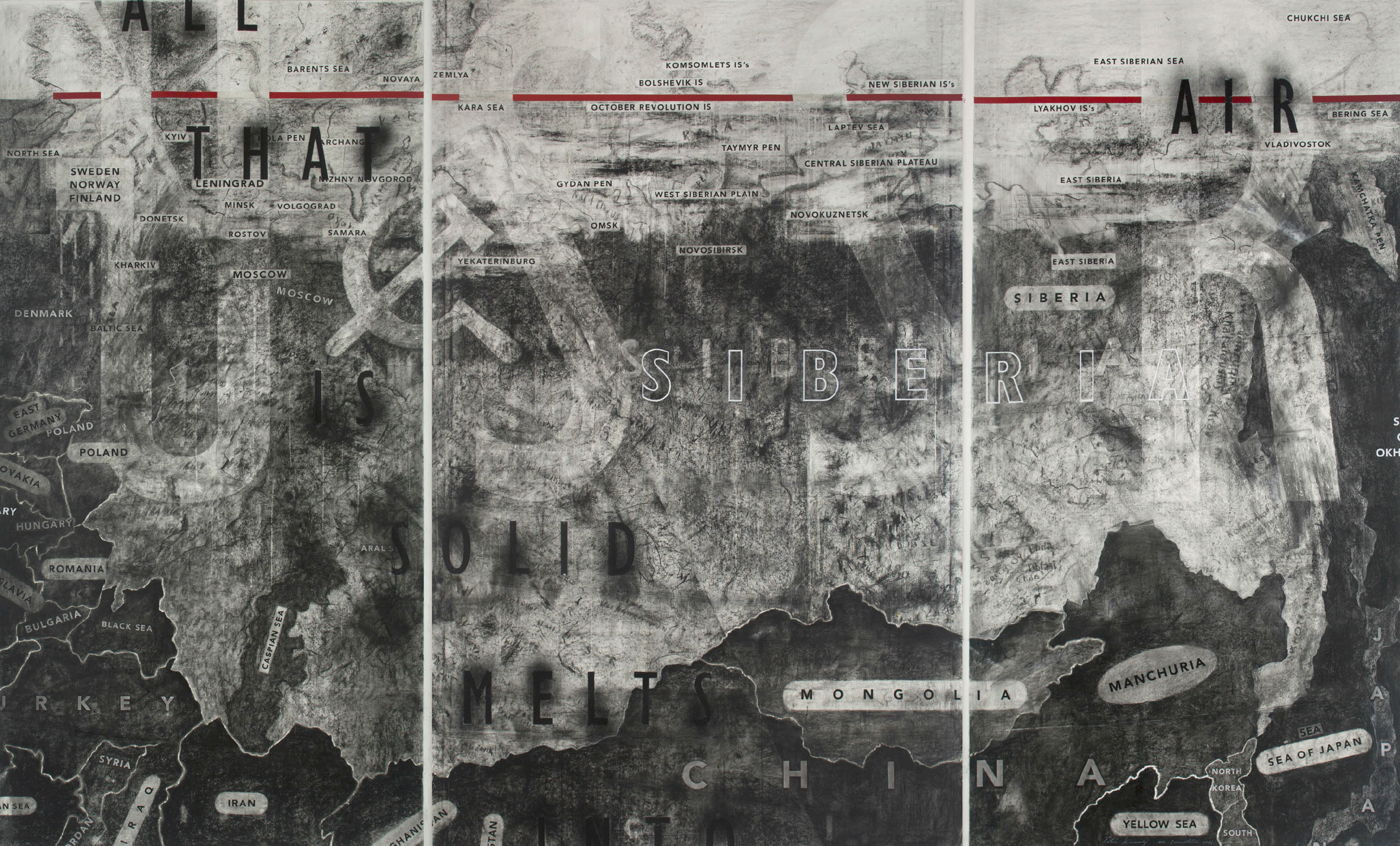Above left: And And And 1992 (completed in 2019) ink, acrylic, other media on paper
Middle: Anthemic Map 1992 (completed in 2019) ink, charcoal, other media on paper
Above right: All that is Solid 1992 (completed in 2013) charcoal, other media on paper
Collection NGA (National Gallery of Australia), Canberra
Dimensions: approx. length of continuous display – 11.0 – 11.20m (including 2 x 15cm spaces between the three works): • image height of centre and drawing at right – 2,400; • image height of drawing at left – 2,420 (approx.) • paper height of each drawing – 2,680; • approx. paper • width of each drawing l-r: 4,250; 2,220; 4,380.
Title: And And And 1992 (completed in 2019) ink, acrylic, other media on paper coll.
Collection NGA (National Gallery of Australia), Canberra
Dimensions: 2680 x 4250 mm (approx. dimensions of paper)
And And And
1992 (completed 2019)
Beginning with the fall of the Berlin Wall in 1989, followed by the breakup of the USSR in 1991, many of the certainties associated with the Cold War dissolve as socialist countries formerly dominated by the USSR reject socialism for capitalism and true national independence.
In the background of this drawing and rendered at a large scale are the letters USA and USSR – the Cold War’s principal adversaries; both are global superpowers and both have global reach. Fragments of a map of Europe float between these letters while the words “West” and “East” occupy the drawing’s upper left and right corners.
The names of the nation states of Europe are repeated across the drawing’s surface – the repetition suggesting fluidity, slippage. Three words, ‘and’, ‘AND’ and ‘&’, stretching from left to right, allude to a feeling at the time of unanticipated possibility as well as unknowable danger. A historic moment – part of the world with a big twentieth century history just might, now, be sliding out of control.

Title: Anthemic Map 1992 (completed in 2019) ink, charcoal, other media on paper
Collection NGA (National Gallery of Australia), Canberra
Dimensions: 2400 x 2220 mm (approx. dimensions of paper)
Anthemic Map
1992 (completed 2019)
Anthemic Map’s background consists of a grid of European national flags and the names of the countries those flags represent. The flags and countries are presented as they existed prior to the end of the Cold War. Superimposed on this background is a map of eastern and western Europe – which, in the context of the Cold War, were referred to as ‘the East’ or ‘the West’ – a method by which ideological difference was efficiently identified.
In the late 1980s, the so-called Baltic and Eastern Bloc states as well as some of the republics within the USSR itself began to rebel against USSR or Russian domination, thereby precipitating a variety of mass independence movements. By and large these actions occurred without bloodshed and were ultimately successful. Although, at the time, no one could be sure of the outcome, the fear of a violent unravelling was an ever present possibility. Not at all peaceful, as it transpired, was the breakup of Yugoslavia into a series of small states: murderous campaigns involving religion and ethnic cleansing ensued for many years.
The drawing can be interpreted as a response to the anxieties and historic grievances that emerged in this period. The words used in the drawing are taken from the lyrics of European national anthems and were selected due to the frequency of their presence in much of the music. These same words, recombined in the drawing, are a reminder of the existence of deeply felt nationalist sentiments. While it aims at a synthesis of turmoil and uncertainty, the drawing also touches on some of the darker emotions unleashed at the time.
Title: All that is Solid 1992 (completed in 2013) charcoal, other media on paper coll.
Collection NGA (National Gallery of Australia), Canberra
Dimensions: 2680 x 4380 mm (approx. dimensions of paper)
All that is Solid
1992 (completed 2013)
In writing the Communist Manifesto, Marx and Engels drew on Shakespeare’s ‘The Tempest’ from which they borrowed the line “All that is solid melts into air”. By applying it to the Communist Manifesto they identified capitalism’s inherent instability – its boom and bust cycles, its relentless reinventions – as a mortal weakness. They asserted that history would eventually see off capitalism and its ideology and so its days were numbered.
The drawing ‘All that is Solid’ reverses Marx and ‘Engels’ teleological vision of the future by way of ironic response. Dissolution shares its meaning with ‘melt’ and it is the historic scale of dissolution that the drawing evokes.
Pentimento technique – charcoal drawing combined with erasure and overlaid with similarly treated transparent-like passages – is a method by which an idea of dissolution is conveyed. So too, the detachment and setting afloat of place names which appear to rise as the former USSR landmass sinks.
Triumphant, and the Cold War won, the US determines to maintain its Cold War global posture as though nothing has changed. Lacking any serious opposition, it attempts to reconstruct nation states in its own image. These interventions involve numerous wars in which Australia, an ally since the second World War, always willingly participates.



